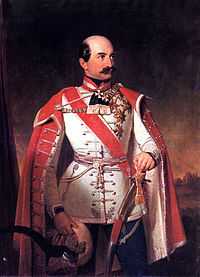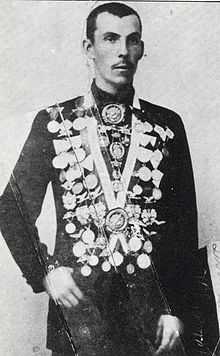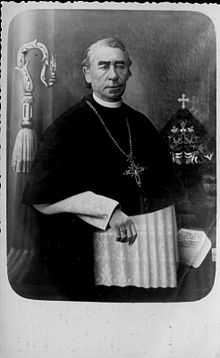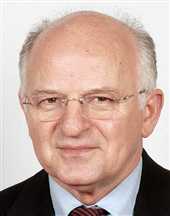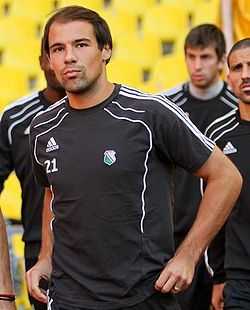Croats of Vojvodina
| |||||||
| Total population | |||||||
|---|---|---|---|---|---|---|---|
| 47,033 | |||||||
| Languages | |||||||
| Croatian | |||||||
| Religion | |||||||
| Roman Catholicism | |||||||
| Related ethnic groups | |||||||
| Bunjevci, Šokci, other South Slavs | |||||||
Croats of Vojvodina (Croatian: Hrvati u Vojvodini, Serbian: Хрвати у Војводини / Hrvati u Vojvodini) are the fourth largest ethnic group in the Vojvodina province of Serbia. According to the 2011 census, there are 57,900 ethnic Croats in Serbia, out of which 47,033 live in Vojvodina.[1]
Population
.png) Linguistic map of Vojvodina according to 1910 census.  Croats in Vojvodina according to the 2002 census - based on settlement data  Croats in Vojvodina (2002 census) |
About two thirds of all Croats in Vojvodina have Bunjevci or Šokci origins.[2] Those of Bunjevci origin constituting the largest part of population in several villages in the Subotica municipality: Bikovo, Gornji Tavankut, Donji Tavankut, Đurđin, Mala Bosna, Ljutovo and Stari Žednik.
Croats of Šokci origin constituting the largest part of population in three villages: Sonta (in the municipality of Apatin), Bački Breg and Bački Monoštor (both in the municipality of Sombor).[3]
| Year | Total population | Croats | % |
|---|---|---|---|
| 1495 | 194,500 | 7,500 | 3.9% |
| 1787 | 476,018 | 38,161 | 8.0% |
| 1828 | 867,281 | 67,692 | 7.8% |
| 1840 | 912,754 | 66,362 | 7.3% |
| 1857 | 1,030,545 | 60,690 | 5.9% |
| 1880 | 1,178,189 | 72,298 | 6.1% |
| 1890 | 1,331,143 | 80,404 | 6.0% |
| 1900 | 1,433,387 | 81,198 | 5.7% |
| 1910 | 1,515,983 | 91,366 | 6,0% |
| 1921 | 1,535,794 | 129,788 | 8.5% |
| 1931 | 1,624,158 | 132,517 | 8.2% |
| 1940 | 1,662,862 | 101,035 | 6.1% |
| 1948 | 1,663,212 | 134,232 | 8.1% |
| 1953 | 1,712,619 | 128,054 | 7.5% |
| 1961 | 1,854,965 | 145,341 | 7.8% |
| 1971 | 1,952,533 | 138,561 | 7.1% |
| 1981 | 2,034,772 | 109,203 | 5.4% |
| 1991 | 2,013,889 | 74,226 | 3.7% |
| 2002[5] | 2,031,992 | 56,546 | 2.78% |
| 2011[1] | 1,931,809 | 47,033 | 2.43% |
| note1: The numbers were adjusted for the present borders of Vojvodina. note2: Croats are counted together with Bunjevci and Šokci for data before 1991. | |||
History
During the 15th century, Croats mostly lived in the Syrmia region. It is estimated that they were a majority in 76 out of 801 villages that existed in the present-day territory of Vojvodina.[6] During 17th century, Roman Catholic Bunjevci from Dalmatia migrated to Vojvodina, where Šokci had already been living. According to some opinions, Šokci might be descendants of medieval Slavic population of Vojvodina where their ancestors might lived since the 8th century. According to other opinions, medieval Slavs of Vojvodina mainly spoke ikavian dialect, which is today rather associated with standard Croatian. Between 1689, when the Habsburg Monarchy conquered parts of Vojvodina, and the end of the 19th century, a small number of Croats from Croatia also migrated to the region.
Before the 20th century, most of the Bunjevac and Šokac populations living in Habsburg Monarchy haven't been nationally awakened yet. Some of their leaders (like Ivan Antunović, Blaško Rajić, Pajo Kujundžić, Mijo Mandić, Lajčo Budanović, Stipan Vojnić Tunić, Vranje Sudarević, Petar Pekić, etc.) worked hardly to awake their Croatian or Yugoslav national feelings.
According to 1851 data, it is estimated that the population of the Voivodeship of Serbia and Banat of Temeschwar, the historical province that was predecessor of present-day Vojvodina, included, among other ethnic groups, 62,936 Bunjevci and Šokci and 2,860 Croats.[7] Subsequent statistical estimations from the second half of the 19th century (conducted during Austro-Hungarian period) counted Bunjevci and Šokci as "others" and presented them separately from Croats (in 1910 Austro-Hungarian census, 70,000 Bunjevci were categorized as "others").[8]

The 1910 Austro-Hungarian census also showed large differences in the numbers of those who considered themselves Bunjevci and Šokci, and those who considered themselves Croats. According to the census, in the city of Subotica there were only 39 citizens who declared Croatian as their native language, while 33,390 citizens were listed as speakers of "other languages" (most of them declared Bunjevac as their native language).[9] In the city of Sombor, 83 citizens declared Croatian language, while 6,289 citizens were listed as speakers of "other languages" (mostly Bunjevac).[10] In the municipality of Apatin, 44 citizens declared Croatian and 7,191 declared "other languages" (mostly Bunjevac, Šokac and Gypsy).[9]
In Syrmia, which was then part of the Kingdom of Croatia-Slavonia, according to the 1910 census results[11] Croats were a relative or absolute majority in Gibarac (843 Croats or 86.46% out of total population), Kukujevci (1,775 or 77.61%), Novi Slankamen (2,450 or 59.22%), Petrovaradin (3,266 or 57.02%), Stari Slankamen (466 or 48.19%), Hrtkovci (1,144 or 45.43% ) and Morović (966 or 41.67%). Other places which had a significant minority of Croats included Novi Banovci (37.70%), Golubinci (36.86%), Kamenica (36.41%), Sot (33.01%), Srijemska Mitrovica (30.32%), Srijemski Karlovci (29.94%) and Ljuba (29.86%).
| Part of a series on |
| Croats |
|---|
 |
|
Europe
North America South America Oceania |
|
Subgroups |
|
In 1925, Bunjevac-Šokac Party and Pučka kasina organized in Subotica the 1000th anniversary celebration of the establishment of Kingdom of Croatia, when in 925 Tomislav of Croatia became first king of the Croatian Kingdom. On the King Tomislav Square in Subotica a memorial plaque was unveiled with the inscription "The memorial plaque of millennium of Croatian Kingdom 925-1925. Set by Bunjevci Croats".[12] Besides Subotica, memorial plaques of King Tomislav were also revealed in Srijemski Karlovci and Petrovaradin.
In the 20th century, most of the Šokci and part of the Bunjevci began to consider themselves Croats.
Expulsion of Croats
In 1990s, during the war in Croatia, members of Serbian Radical Party organized and participated in the expulsion of the Croats in some places in Vojvodina. The President of the Serbian Radical Party, Vojislav Šešelj is indicted for participation in these events.[13] According to some estimations, the number of Croats which have left Vojvodina under political pressure of the Milošević's regime might be between 20,000 and 40,000.[14]
Politics
The Croats of Vojvodina are politically represented by the Democratic League of Croats in Vojvodina. The former Croatian President Stjepan Mesić has urged the Serbian Government to make Croats a recognized minority with a seat in Parliament, as part of the new Constitution of Serbia.
Other parties of Croats in Vojvodina are: Demokratska zajednica Hrvata (Democratic Union of Croats), Hrvatska bunjevačko-šokačka stranka (Croatian Bunjevac-Šokac Party), Hrvatski narodni savez (Croatian national alliance) and Hrvatska srijemska inicijativa (Croatian Syrmian Initiative).
Hrvatsko nacionalno vijeće Republike Srbije (National Council of Croats of Republic of Serbia) is, according to its Statute, a body of self-government of Croat minority in Serbia.
Language
The Croatian language is one of the six official languages of Vojvodina.
Croatian names of settlements
| Settlement | Croatian names |
|---|---|
| Bajmok | Bajmak |
| Ljutovo | Mirgeš |
| Stari Žednik | Žednik |
| Sonta | Sonta |
| Bački Breg | Bereg |
| Bački Monoštor | Monoštor |
| Stara Bingula | Stara Bingula |
| Sot | Sot |
See also
- Croats of Serbia
- Persecution of Croats in Serbia during the war in Croatia
- Croats
- Ethnic groups of Vojvodina
- Bunjevci
- Šokci
References
- ↑ 1.0 1.1 Republički zavod za statistiku Republike Srbije
- ↑ Lazo M. Kostić, Vojvodina i njene manjine, Novi Sad, 1999.
- ↑ Popis stanovništva, domaćinstva i stanova u 2002, Stanovništvo - nacionalna ili etnička pripadnost, podaci po naseljima, knjiga 1, Republički zavod za statistiku, Beograd, Februar 2003.
- ↑ Tóth Antal: Magyarország és a Kárpát-medence regionális társadalomföldrajza, 2011, p. 67-68
- ↑ Statistical Office of the Republic of Serbia, Population Census 2002
- ↑ Károly Kocsis, Saša Kicošev: Changing ethnic patterns on the present territory of Vojvodina
- ↑ Dr Dušan J. Popović, Srbi u Vojvodini, knjiga 3, Novi Sad, 1990.
- ↑ Juraj Lončarević: Hrvati u Mađarskoj i Trianonski ugovor, Školske novine, Zagreb, 1993, ISBN 953-160-004-X
- ↑ 9.0 9.1
- ↑ http://www.talmamedia.com/php/district/district.php?county=B%E1cs-Bodrog
- ↑ A magyar szent korona országainak 1910. évi népszámlálása; Budapest 1912
- ↑ Mario Bara: Hrvatska seljačka stranka u narodnom preporodu bačkih Hrvata (The Croatian Pesants Party in the national movement of Bačka Croats), p. 63
- ↑ Vojislav Seselj indictment
- ↑ Hrvatska nacionalna manjina u Srbiji
- ↑ Croatian National Council of the Republic of Serbia
| ||||||||||||||
| |||||||||||||
